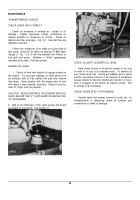TM-5-3805-254-14-P-1 - Page 43 of 590
OPERATION
available; therefore, it is not always possible to state
exactly at which speed to shift unless all the variable
facts are known.
A good rule is "shift down at the same
engine speed the tachometer indicated immediately after
shifting up." On a steep grade, start down-shift before
the engine actually pulls down to shifting speed,
because the truck will lose speed while shifting gears.
Failure to shift down at the right time, or a delayed
down-shift will result in the engine failing to reach full
power, and make another down-shift necessary.
When approaching a hill, open throttle smoothly to
start the up-grade at full power, then shift down as soon
as the engine has dropped to shifting speed.
Do not
wait until the engine is below shifting speed.
Less gear
shifts will be required and average road speed will be
higher if this is done smoothly.
DOWNHILL OPERATION
The Cummins Diesel is effective as a brake on
downhill grades, but care must be exercised not to
overspeed the engine going downhill.
The governor has
no control over engine speed when it is being pushed by
the loaded vehicle.
Never turn off the switch key while going downhill.
With
the engine still in gear, fuel pressure will build up against
the shut-down valve and may prevent it from opening
when the switch key is turned on.
USE
BRAKE
AS
NEEDED
TO
PREVENT
EXCESSIVE ENGINE SPEEDS
Use a combination of brakes and gears to keep vehicle
under control at all times, and to KEEP ENGINE SPEED
BELOW RATED GOVERNED RPM.
AUXILIARY BRAKING SYSTEM
Some trucks are equipped with auxiliary braking
equipment which utilize the engine as a braking device
to reduce wear on the normal truck brake system.
CUMMINS ENGINE COMPANY, INC.
WARRANTY
DOES NOT COVER ENGINE DAMAGE RESULTING
FROM USE OF AUXILIARY BRAKING SYSTEMS
SINCE SUCH DAMAGE CAN BE CAUSED BY
IMPROPER APPLICATION, LACK OF MAINTENANCE,
INCORRECT USE OR MALFUNCTION OF SUCH
BRAKES.
EXHAUST BRAKE
So called because closing of a valve in the exhaust
system retains compressions pressures within the
exhaust manifolding and engine cylinders to utilize these
pressures to reduce speed.
Compression braking is
most efficient when engine is permitted to turn at same
speeds as for efficient power and may be used as much
and as often as possible.
JACOBS ENGINE BRAKE
This braking system converts the engine into a
power absorbing air compressor using a master slave
piston arrangement to open engine exhaust valves near
top of engine compression stroke releasing pressures to
exhaust.
The effect being a net energy loss since work
done during compression is not returned during the
expansion process.
The operator selects a gear which will provide a
balance between engine speed and road speed.
If
engine exceeds maximum rated rpm for a designed road
speed, a lower gear can be selected, or intermittent use
can be made of vehicle service brakes.
Selection of a
lower gear will generally allow complete control of
vehicle by the brake leaving the service brakes in
reserve for emergency stops.
HIGH-ALTITUDE OPERATION
Engines lose horsepower when operated at high
altitude because the air is too thin to burn as much fuel
as at sea level.
This loss is about 3 percent for each
1000 ft.
(304.8 m) altitude above sea level for a
naturally aspirated engine.
Most turbocharged engines
are rated for higher altitudes than naturally aspirated
engines.
(See Engine Specification Tables at front of
this manual.) An engine will have a smoky exhaust at
high altitude unless a lower gear is used so the engine
will not demand full-fuel from the fuel system unless the
engine is altitude compensated by the use of a
turbocharger.
Shift gears as needed to avoid exhaust
smoke.
37
Back to Top




















